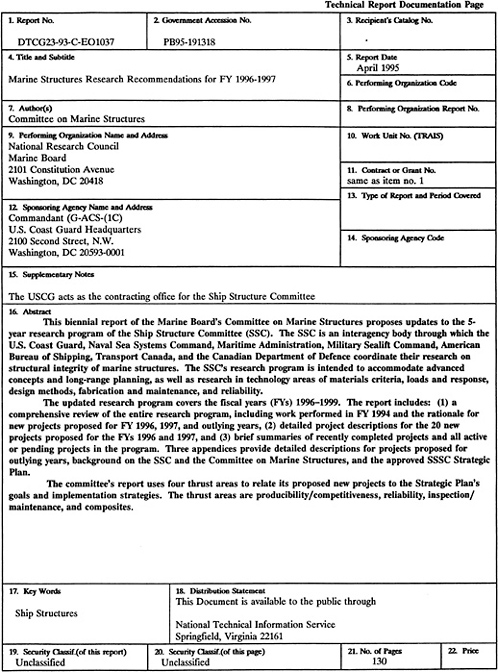APPENDIX C
SHIP STRUCTURE COMMITTEE STRATEGIC PLAN
On June 8, 1992, the SSC unanimously endorsed the SSC Strategic Plan. On May 10, 1994, the Executive Committee of the SSSC reviewed the Strategic Plan to determine the need for updating it. The Purpose and Scope statements were revised, as were the plans for implementation contained in “taking action now.” At its annual meeting on June 13, 1994, the SSC approved these changes. The revised plan is reproduced in its entirety below.
|
SHIP STRUCTURE COMMITTEE STRATEGIC PLAN Background The annual fall meeting of the Ship Structure Committee (SSC) was held on 16 October 1991. During the meeting, the results from the Subcommittee Strategy Meeting held in July 1991 were presented to the SSC. The Strategy Meeting was convened to review the SSC Charter and redefine the SSC's purpose and scope. The committee has approved the revised Purpose and Scope Statements and concurred with the subcommittee 's plans for implementation contained in “Taking Action Now.” This plan outlines how best to meet these newly approved statements. Purpose The purpose of the Ship Structure Committee is to promote safety, economy, marine environmental protection, and education in the North American maritime industry through the advancement of marine structures technology. Scope The Ship Structure Committee shall carry out the following activities:
|
Goal for the 1990s Critical Trends and Factors The following trends and factors define the present reality and future expectations of the U.S. and Canadian maritime industry. The SSC must be cognizant of these when formulating its policies:
|
|
National Goals The Ship Structure Committee recognizes the following national goals relating to the maritime industry. It will support research and development that focuses on these goals.
Assumptions
Implementation of the SSC Goals: Strategies for the 1990s In light of the critical factors and trends, national goals, and the assumptions noted above, the Ship Structure Committee will, through sponsorship of research projects, address the following topics:
|
Taking Action Now: Implementation by the SSC What actions should the SSC take to implement the new Strategic Plan? Each of these actions needs further definition and planning prior to implementation, but each will serve to make better use of resources through more innovative processes. The following should be accomplished within the next three years:
|
The SSSC chairman will appoint subcommittee members to husband the implementation of the items listed above. The SSSC chairman will report the subcommittee's progress to the SSC at the biannual SSC meetings. |







